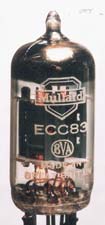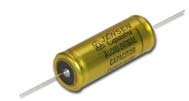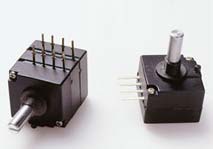Straightforward Modifications
This section describes some straighforward modifications.Changing tubes
The original kit contained National EL-34 tubes, and I can't even remember the brand of the ECC82 and ECC83 tubes anymore (although I can remember that turning on the amp made the heaters of the ECC82s light up very heavily for a moment). The original tubes sound a bit harsh, and not so refined.After a couple of months I've changed all the tubes to Golden Dragon tubes. The first few years I've used these tubes with great fun, and without any problems whatsoever. The overall sound, compared to the original tubes, is more "massive", and also a bit more "refined".
Later, after changing the topology of the amp as well, I've changed the ECC83s to Mullard E83CCs, and the EL-34s to Philips. I've performed a lot of experiments with different brands, and here are some (not all, I've listened to many more tubes) of my findings (vague, cryptic, imprecise, and non-technical):
ECC83 . The Mullard seems to be unbeatable, because they excell in all aspects. All instruments have their own characteristics (guitars are not only snares, but there is wood as well), spatial information is very precise, articulation, drive, dynamics, etc. etc. The is a very good tube as well! Can follow the Mullard quite closely. A little bit more closed. Beautiful bass. The Telefunken is a bit better than Golden Dragon or JJ, but not like a Mullard.With the JJ the depth of image disappears, but the remaining 2D image is good, pin-pointing is excellent, and the instruments are decouples. Treble is clean, but not connected to the rest. Voices are analytical. It precisely follows all that happens in the music. The Tesla 803 is fine as well, good pin-pointing. Treble less natural, less attack on drums. The Tungsram is flat, harsh, dull.

EL34. The Philips has a coherent sound, dynamic in combination with ease, excellent imaging. The JJs have quite some coloration (horn-speaker-like). Treble is brilliant, but analytical. The 3D-imaging is not so large, the instruments are intermangled. Dynamics are OK, and the drive is good. The JJs are better than the Golden Dragons. These are more detailed, but harsh. Finally, the RFT is flat, dull, bass not in phase with the rest. They have a coherent sound however.

Please remind that these findings are personal, and that they heavily depend on the topolgy of the amp, the interaction with the speakers (in my case Audio Note E), and the source used (which is a DIY-DAC). For more info on EL34, see the interesting pages of Jogi.
Changing coupling capacitors
I've changed the ERO coupling capacitors by Jensen paper-in-oil types. This result in more brilliant treble, and a wider sound stage.The choice of this cap has also been motivated by some "toy-" test, where we've put different types of caps between a CD player and an amp. The paper-in-oil cap was the only cap that seemed to have no audible impact compared to the situaion where no cap was applied.

Volume control
I've changed the original volume control with a Noble volume control. It's not straightforward to mount this control, but it's worth the effort. I've by-passed the balance control, because I don't use it. The sound becomes 'cleaner'.
Switch
I only use a CD player for my amp, so I've decided to by-pass the switch as well, and get rid of that strange computer cable out of my amp. I've used a very thin single strand silver wire, isolated with teflon for that. The results are stunning. More direct sound, much clearer.Feedback
Overall feedback results in a higher overall bandwidth, and a lower output impedance. Inside the Classic, the overall feedback is about 11dB. The feedback can be influenced by changing R51 (and R48). By shortcutting these 2 resistors, the overall feedback will be eliminated in both channels. Lowering the overall feedback is not interesting for all of you. Some speakers become 'fluffy' in the bass. If you consider lowering the feedback, I would suggest to perform audible experiments, because the effects become very apparant if things go wrong. For this purpose, I just apply a potmeter over the resistance, so that I can experiment very quickly. If the effect works for you, the result is a overall improvement of dynamics and imaging.
Triode Mode
The Classic is based on an ultra-linear output stage. The screen grid of a penthode is attached to an additional tap on the end transformer. The screen grid will vary in a certain ratio of the anode, order of magnitude 43%. In essence this is a form of local feedback. The characteristics of a stage like this is between a penthode and triode operation of the tube. The goal is to increase linearity. The output stage can be modified to a triode-mode stage (see this Sound Practices article for some backgrounds). For this purpose, the screen grid should be loosened from the transformer, and attached to the anode via a resistor (see the thick wire in the scheme below, which has to be done for all 4 output tubes). The effect is a rich harmonic sound. The reduction of power could be a problem with low efficiency speakers, but the audible effect is as if the amplifier has even more power. Detailed info about push-pull amplifier topologies can be found at TubeCAD, which is a web version of the original article by David Hafler in Audio Engineering, November 1951. Norman Crowhurst explains that each topology is appropiate, but it should be implemeted properly.
All of this combined
The results of all these modifications combined gave me a lot of pleasure. The musical performance of the amplifier seems to have increased drastically. It is as if a thick curtain in front of the speakers has been removed. I've measured only the output impedance of the whole, which is 4.8 Ohms on the 8 Ohm tap, and 2.5 Ohms on the 4 Ohm tap. This implies that the speaker should be very easy to drive, making these modifications not generally applicable!next->